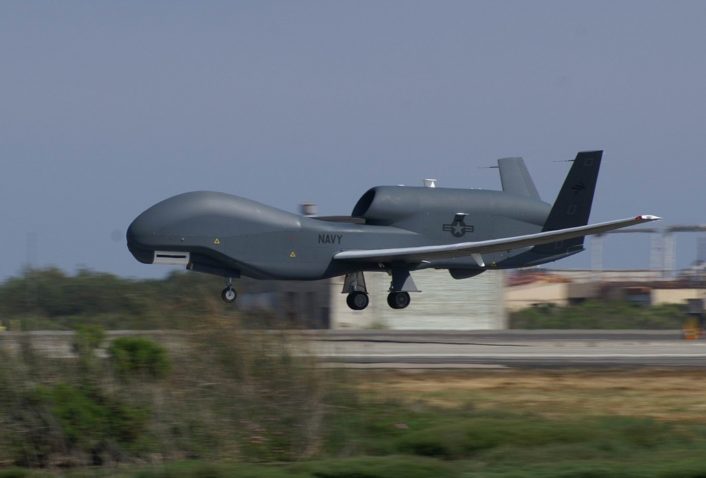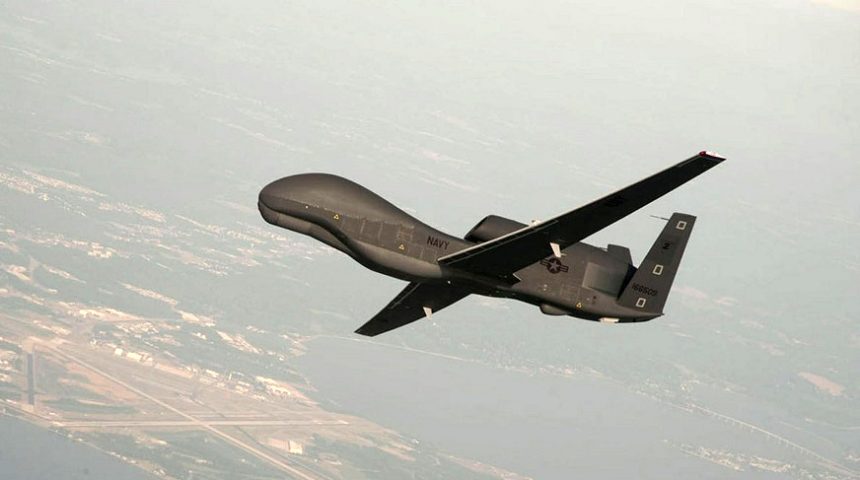The Class-A mishap reduced the BAMS-D fleet to just two operational drones remaining.
An RQ-4A BAMS-D (Broad Area Maritime Surveillance – Demonstrator) of the U.S. Navy was damaged by unspecified Foreign Object Debris (FOD) while taking off for a mission in the Middle East. The incident, first reported by USNI News on December 12, happened on Nov. 26, 2019.
Here’s the full statement from the US 5th Fleet:
“On 26 November, 2019, a U.S. Navy RQ-4A Broad Area Maritime Surveillance Aircraft Demonstration (BAMS-D) struck foreign object debris (FOD) during takeoff while supporting operations in the U.S. Fifth Fleet area of responsibility. The mishap resulted in damage to the port side of the aircraft. No personnel were injured. A mishap investigation is ongoing and we therefore have no further releasable details.”
The Navy didn’t provide details about the airbase from where the drone was operating, however various versions of Global Hawk from the Air Force and Navy, including the EQ-4B BACN (Battlefield Airborne Communications Node), are known to fly out of Al Dhafra Airbase in the United Arab Emirates.
According to USNI News, a summary of the accident stated that the US Navy categorized the damage as a Class-A mishap, which means it caused $ 2,500,000 or more worth of damage. Class-A mishaps criteria may involve also the total loss of the aircraft, however that doesn’t seem to be the case as the statement mentioned only damages.

The US Navy acquired five RQ-4A from the Air Force for the BAMS program which resulted in the development of the MQ-4C “Triton”. After the loss of a first airframe in 2012 in the Chesapeake Bay and another one shot down in June 2019, this incident may have reduced the total operational fleet to just two BAMS-D. Meanwhile, the US Navy introduced in service the MQ-4C which should replace the BAMS-D when it reaches the Initial Operational Capability in 2021.
Here’s what our Editor David Cenciotti wrote back in June about the BAMS and BAMS-D programs:
The BAMS-D is a RQ-4A Global Hawk High-Altitude Long Endurance (HALE) Unmanned Aircraft System (UAS) and provides real-time intelligence, surveillance and reconnaissance missions (ISR) over vast ocean and coastal regions.
As part of what was initially the Global Hawk Maritime Demonstration program, beginning in 2006, before the Global Hawk platform was selected as the BAMS winner, the U.S. Navy purchased five RQ-4As from the U.S. Air Force: at least one RQ-4A Block 10 was assigned to the VX-20 at Patuxent River for test purposes some time ago.
Although the test aircraft are referred to as BAMS demo drones, they are sensibly different from the actual MQ-4C BAMS Triton that, in spite of the same basic airframe, has a completely different radar and surveillance equipment. Dealing with the U.S. Navy’s MQ-4C “Triton” Broad Area Maritime Surveillance (BAMS), this is an ISR (Intelligence Surveillance Reconnaissance) platform that will complement the P-8A Poseidon within the Navy’s Maritime Patrol and Reconnaissance Force family of systems: for instance, testing has already proved the MQ-4C’s ability to pass FMV (Full Motion Video) to a Poseidon MPA (Maritime Patrol Aircraft). An advanced version than the first generation Global Hawk Block 10, the drone it is believed to be a sort of Block 20 and Block 30 Global Hawk hybrid, carrying Navy payload including an AN/ZPY-3 multi-function active-sensor (MFAS) radar system, that gives the Triton the ability to cover more than 2.7 million square miles in a single mission that can last as long as 24 hours at a time, at altitudes higher than 10 miles, with an operational range of 8,200 nautical miles. The U.S. Navy plans to procure 68 aircraft and 2 prototypes.









